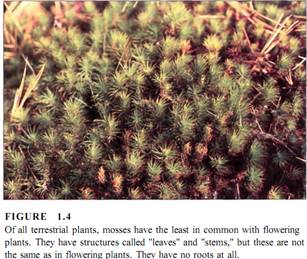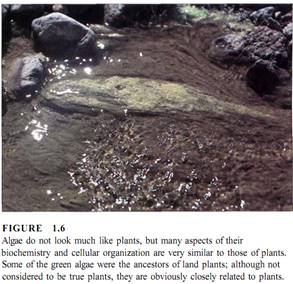


 النبات
النبات
 الحيوان
الحيوان
 الأحياء المجهرية
الأحياء المجهرية
 علم الأمراض
علم الأمراض
 التقانة الإحيائية
التقانة الإحيائية
 التقنية الحيوية المكروبية
التقنية الحيوية المكروبية
 التقنية الحياتية النانوية
التقنية الحياتية النانوية
 علم الأجنة
علم الأجنة
 الأحياء الجزيئي
الأحياء الجزيئي
 علم وظائف الأعضاء
علم وظائف الأعضاء
 الغدد
الغدد
 المضادات الحيوية
المضادات الحيوية|
Read More
Date: 24-10-2016
Date: 23-10-2016
Date: 9-11-2016
|
Introduction to Plants and Botany
The study of biology historically has been divided into two realms: botany, for plants, and zoology, for animals. This suggests that all living organisms are either plants or animals, a theory that presented little problem when applied to giraffes and elm trees. But when bacteria were discovered, there resulted some puzzlement regarding to which realm these organisms should be relegated. Further research and discoveries only increased the uncertainty until, in 1959, Professor R.H. Whittaker proposed a five-kingdom system as follows: Monera, Protista, Fungi, Plants, and Animals. Members of the Monera kingdom are prokaryotic (having no definite nuclei) cells such as bacteria and blue-green algae. Members of the Protista kingdom are eukaryotic (having true nuclei) cells. Members of the Fungi kingdom are plantlike but lack chlorophyll. Such organisms, therefore, do not manufacture carohydrate as do green plants, and must therefore live as either parasites or saprophytes (organisms that live on dead matter). Because people are so accustomed to classifying organisms as either plant or animal, this system has been slow to take hold. And while this five-kingdom system does not solve all problems relating to classification, it does constitute a step forward.
Botany is the scientific study of plants. This definition requires an understanding of the concepts "plants" and "scientific study." It may surprise you to learn that it is difficult to define precisely what a plant is. Plants have so many types and variations that a simple definition has many exceptions, and a definition that includes all plants and excludes all non-plants may be too complicated to be useful. Also, biologists do not agree about whether certain organisms are indeed plants. Rather than memorizing a terse definition, more is gained by understanding what plants are, what the exceptional or exotic cases are, and why botanists disagree about certain organisms.
PLANTS
Your present concept of plants is probably quite accurate: Most plants have green leaves, stems, roots, and flowers (Fig. 1.1). But you can think of exceptions immediately. Conifers such as pine, spruce, and fir have cones rather than flowers (Fig. 1.2), and many cacti and succulents do not appear to have leaves. But both conifers and succulents are obviously plants because they closely resemble organisms that unquestionably are plants. Similarly, ferns and mosses (Figs. 1.3 and 1.4) are easily recognized as plants. Fungi, such as mushrooms (Fig. 1.5) and puffballs, were included in the plant kingdom because they are immobile and produce spores, which function somewhat like seeds. But biologists no longer consider fungi to be plants because recent observations show that fungi differ from plants in many basic biochemical respects.




Algae are more problematical. One group, the green algae (Fig. 1.6), are similar to plants in biochemistry and cell structure, but they also have many significant differences. Some botanists conclude that it is more useful to include green algae with plants; others exclude them, pointing out that some green algae have more in common with the seaweeds known as red algae and brown algae. Arbitrarily declaring that green algae are or are not plants solves nothing; the important thing is to understand the concepts involved and why disagreement exists.


PLANTS & PEOPLE
Plants and people affect each other. Most obvious perhaps are the ways that people benefit from plants: They are the sources of our food, wood, paper, fibers, and medicines. It is difficult to excite students by listing the world production of wheat and lumber in metric tons, but just consider what your life would be like without products such as chocolate, sugar, vanilla, cinnamon, pepper, mahogany, cherry wood, ebony, cotton, linen, roses, orchids, or the paper that examinations are written on. The oxygen we breath comes entirely from plants. Plants affect each of us every day, not simply by keeping us alive but also by providing wonderful sights, textures, and fragrances that enrich our existence.
However, plants and people affect each other in ways that are not readily apparent in our day-to-day lives. Below are a few important topics that you should be aware of. Articles about these appear in the news, and you should think about their importance and how you—as an actual biological organism— interact with the other organisms on this planet.
Biotechnology is a set of laboratory techniques that allow us to alter plants and animals, giving them new traits and characteristics. Farmers have done this for thousands of years with plant breeding and animal husbandry, but biotechnology permits much more rapid, extensive alterations. We must now consider whether such manipulations are safe and worthwhile.
Global warming is caused by a build-up of carbon dioxide in our atmosphere due to the burning of coal, oil, gas, and the trees of forests everywhere (not just tropical rainforests). The carbon dioxide traps heat, preventing Earth from radiating excess energy into space. Global warming could affect the melting of polar ice caps, the circulation of ocean currents, and even the amount and pattern of rainfall. Preserving our forests and planting more trees might help stop and reverse global warming. But the possibility exists that global warming is preventing the occurrence of another ice age. We need more information before deciding whether global warming is harmful.
Desertification is the conversion of ordinary forest or grassland to desert. Accurate measurements are difficult, but it appears that deserts may be spreading as people cut shrubs and trees for firewood and allow goats to eat remaining vegetation. Once an area has been converted to desert, its soil is rapidly eroded away, making recovery difficult. Something as simple as cheap solar cookers might prevent the Sahara desert from spreading farther across Africa.
Habitat loss results when an area is changed so much that a particular species can no longer survive in the area. Significant causes are the construction of highways, housing subdivisions, and shopping malls with enormous parking lots; these eliminate almost all species from an area. But habitats are also lost by logging, farming, mining, damming rivers, and spilling toxic chemicals. As habi-tat is lost, plants or animals must try to survive on the smaller re-maining habitat. Once too little habitat is left, species usually become extinct.
Introduced exotics are organisms that are native to one part of the world but are brought to another part, where they thrive. Exam-ples of introduced exotic animals are Medfly fruit flies in California and zebra mussels in the Great Lakes region. Water hyacinth and kudzu (a vine) were introduced to the United States and are now proliferating and reproducing so vigorously that they are crowding out many plants that normally grow here.
It is simply not realistic to believe that we humans will stop all these activities that have negative impacts on our environment and on the other species with which we share this planet. But we can search for ways to minimize the harm we cause by recycling, con-serving resources, and avoiding products that require pollution- causing manufacturing techniques.

suffering in their final stages, which may last for months. We have drugs that can arrest breathing so that a person dies painlessly and peacefully. Science developed the drugs and can tell us the metabolic effects of using them, but it cannot tell us if it is right to use them to help a person die and avoid pain. For that answer, it is necessary to turn to a religious or philosophical method of contemplating the world. Biological advances have made us capable of surrogate motherhood, of detecting fetal birth defects early enough to allow a medically safe abortion, and of producing insecticides that protect crops but pollute the environment. These advances have made it more important than ever for us to have well-developed moral and philosophical systems for assessing the appropriateness of various actions.
Finally, we must never forget that we are human beings with emotions. Even if we learn everything that can be known scientifically about plants, a beauty still exists which cannot be analyzed and understood but only felt and appreciated.



|
|
|
|
زراعة الأسنان.. بين بريق التجميل وحاجة المريض إليها
|
|
|
|
|
|
|
وفاة أول رجل خضع لزراعة كلية خنزير.. والمستشفى يوضح الأسباب
|
|
|
|
|
|
اختتام الأسبوع الثاني من الشهر الثالث للبرنامج المركزي لمنتسبي العتبة العباسية
|
|
|
|
راية قبة مرقد أبي الفضل العباس (عليه السلام) تتوسط جناح العتبة العباسية في معرض طهران
|
|
|
|
جامعة العميد وقسم الشؤون الفكرية يعقدان شراكة علمية حول مجلة (تسليم)
|
|
|
|
قسم الشؤون الفكريّة يفتتح باب التسجيل في دورات المواهب
|